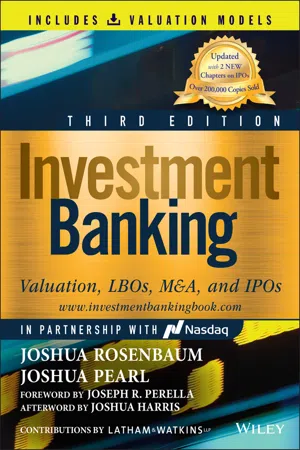
Investment Banking
Valuation, LBOs, M&A, and IPOs (Book + Valuation Models)
- English
- ePUB (mobile friendly)
- Available on iOS & Android
Investment Banking
Valuation, LBOs, M&A, and IPOs (Book + Valuation Models)
About this book
An essential, all-in-one guide to investment banking and valuation, complete with downloadable models – this new edition reflects valuable contributions from Nasdaq and the global law firm Latham & Watkins LLP plus access to the online valuation models and course.
The thoroughly revised Third Edition of Investment Banking: Valuation, LBOs, M&A, and IPOs (Book + Valuation Models) delivers the most current discussion of valuation and deal-making fundamentals essential to the work of investment bankers, private equity professionals, hedge fund investors, corporate lawyers, executives, and students. Drawing on over four decades of combined experience in investment banking and investing, authors Joshua Rosenbaum and Joshua Pearl explain how to perform the valuation work and financial analysis at the core of Wall Street – comparable companies, precedent transactions, DCF, LBO, M&A analysis...and now IPO analytics and valuation. Using a step-by-step, how-to approach for each methodology, the authors build a chronological knowledge base and define key terms, financial concepts, and processes throughout the book.
Now, over 10 years after the release of the first edition, the book is more relevant and topical than ever. The book has sold over 250, 000 copies and is used in over 200 universities globally. It has become a go-to resource for investment banks, private equity, investment firms, and corporations undertaking M&A transactions, LBOs, IPOs, restructurings, and investment decisions. While the fundamentals haven't changed, the environment must adapt to changing market developments and conditions. As a result, Rosenbaum and Pearl have updated their widely-adopted book accordingly, turning the latest edition into a unique and comprehensive training package.
The Third Edition includes six downloadable valuation model templates: Comparable Companies Analysis, Precedent Transactions Analysis, Discounted Cash Flow Analysis, Leveraged Buyout Analysis, M&A Analysis, and IPO Valuation, available at www.wiley.com/go/investmentbanking3e.
Frequently asked questions
- Essential is ideal for learners and professionals who enjoy exploring a wide range of subjects. Access the Essential Library with 800,000+ trusted titles and best-sellers across business, personal growth, and the humanities. Includes unlimited reading time and Standard Read Aloud voice.
- Complete: Perfect for advanced learners and researchers needing full, unrestricted access. Unlock 1.4M+ books across hundreds of subjects, including academic and specialized titles. The Complete Plan also includes advanced features like Premium Read Aloud and Research Assistant.
Please note we cannot support devices running on iOS 13 and Android 7 or earlier. Learn more about using the app.
Information
PART One
Valuation
CHAPTER 1
Comparable Companies Analysis
| Step I. | Select the Universe of Comparable Companies |
| Step II. | Locate the Necessary Financial Information |
| Step III. | Spread Key Statistics, Ratios, and Trading Multiples |
| Step IV. | Benchmark the Comparable Companies |
| Step V. | Determine Valuation |
SUMMARY OF COMPARABLE COMPANIES ANALYSIS STEPS
- Step I. Select the Universe of Comparable Companies. The selection of a universe of comparable companies for the target is the foundation of comps. While this exercise can be fairly simple and intuitive for companies in certain sectors, it can prove challenging for others whose peers are not readily apparent. To identify companies with similar business and financial characteristics, it is first necessary to gain a sound understanding of the target. As a starting point, the banker typically consults with peers or senior colleagues to see if a relevant set of comparable companies already exists internally. If beginning from scratch, the banker casts a broad net to review as many potential comparable companies as possible. This broader group is eventually narrowed, and then typically further refined to a subset of “closest comparables”. A survey of the target’s public competitors is generally a good place to start this exercise.
- Step II. Locate the Necessary Financial Information. Once the initial comparables universe is determined, the banker locates the financial information necessary to analyze the selected comparable companies and calculate (“spread1”) key financial statistics, ratios, and trading multiples (se...
Table of contents
- Cover
- Additional Resources
- About the Authors
- About the Editors
- Foreword
- Acknowledgments
- Disclaimer
- Introduction
- Part One Valuation
- Part Two Leveraged Buyouts
- Part Three Mergers & Acquisitions
- Part Four Initial Public Offerings
- Afterword
- Bibliography and Recommended Reading
- Index
- Advert
- ACCESS PIN
- EULA